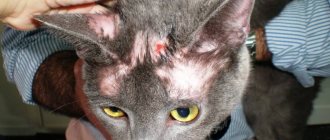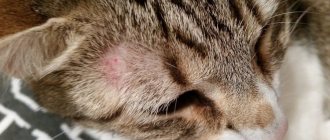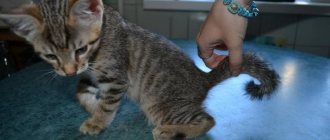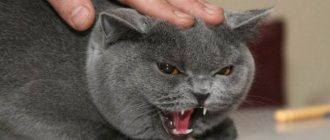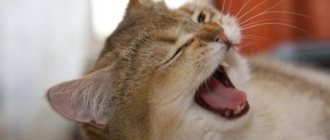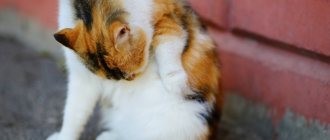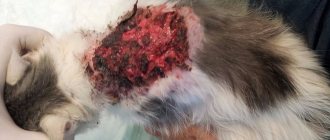Cause of runny nose
There are various causes of a runny nose in a cat. Depending on them, separate treatment is selected. For example, if a cat is coughing and sneezing due to a bacterial infection, an antiviral drug is not given, but antibiotics are used.
Colds in cats
Cold or viral infection
ARVI in cats is quite common. It is accompanied by the following clinical symptoms:
- dry cough;
- rhinitis - inflammation of the nasal mucosa, accompanied by mucus secretion;
- increased body temperature;
- occasional sneezing;
- symptoms of illness - weakness, fatigue, lethargy, drowsiness, sudden loss of strength, the cat constantly sleeps, rarely moves.
Important! Unlike a bacterial infection, a cold is not accompanied by the discharge of pus. But if there is no therapy for a long time, the pathogenic microflora is gradually activated, so a complication appears in the form of infection.
Fever
High body temperature accompanies many diseases:
- conjunctivitis;
- rhinitis;
- inflammation of various sinuses;
- tracheitis, bronchitis, pneumonia;
- ARVI.
Elevated body temperature always accompanies pathological conditions. Normally it does not rise. The temperature rises to increase the body's resistance and destroy bacteria and viruses.
Typically, viral diseases are accompanied by a slightly elevated body temperature. After 3 days of illness it gradually decreases.
If the cat gets sick with a bacterial infection, the temperature rises significantly. If there is no antibacterial treatment, it does not decrease, and the animal’s condition gradually worsens.
Allergic runny nose
Some animals experience allergic rhinitis. This is a condition in which exposure to an antigen leads to irritation and inflammation of the nasal mucosa. This condition occurs over a long period of time upon contact with an allergen.
The cause may be household dust, household chemicals, pollen from certain plants, or food. The owner must not only use antihistamines, but also completely eliminate the allergen from the animal’s life so that rhinitis does not recur.
Rhinitis, sinusitis, sinusitis
If a cat develops rhinitis, the inflammatory process can gradually spread to the sinuses. Initially, the animal secretes serous exudate from the nose. If there is no treatment for a long time, the bacterial infection begins to multiply. Therefore, transparent snot is gradually replaced by green discharge. A bacterial infection cannot be cured with antiviral drugs; the animal’s condition gradually worsens. This leads to purulent sinusitis with increased body temperature, swelling of the face, and pain in the head.
Rhinitis
Important! The cat or kitten becomes restless, sleeps poorly, and is tormented by constant pain.
Allergies and mucosal irritation
Light, clear snot, sneezing and watery eyes are all symptoms of an allergic reaction in pets. Hypersensitivity can be caused by both food and external irritants. Common allergens:
- Household chemicals.
- Flea shampoos.
- Preparations for antiparasitic treatment.
- Dust and plant pollen.
Treatment begins with identifying the stimulus. If you succeed in identifying the allergen and eliminating its effect, you don’t have to worry - the animal will no longer encounter such a disease. As a rule, after the irritant ceases, the symptoms of rhinitis quickly subside and completely disappear within a few days.
If the allergen cannot be identified, and the pet’s condition worsens every day, drug therapy is necessary. In particularly severe cases, the cat will have to take antihistamines for life.
You may be interested in: Cleaning the anal glands at home: what you need to know
Green snot is a danger signal
Green snot signals the addition of bacterial microflora. It could be as follows:
- streptococci;
- staphylococci;
- Pseudomonas aeruginosa;
- pneumococci.
Snot in a kitten, cat and cat: how to treat it
These are the main bacteria that cause your pet to snot. But there may be other pathogenic microorganisms. The green color is formed due to the proliferation of bacteria, the action of the immune system, which secretes lymphocytes and inflammatory mediators. The greater the immune response, the greater the swelling and exudate.
Gradually, rhinitis with green snot becomes more complicated, leading to the following diseases:
- rhinitis;
- sinusitis;
- sinusitis;
- pharyngitis;
- frontitis.
Purulent exudate can pass not only into the sinuses, but down the respiratory system. First, pharyngitis appears, which then develops into tracheitis, bronchitis and pneumonia. This condition is common, especially in cats with reduced immune reactivity.
Purulent exudate has a thick structure, so it often completely clogs the nasal passages. The pet begins to breathe heavily and snore in its sleep. In severe cases, body temperature rises.
In rare cases, the infection can travel throughout the body, causing infectious inflammation of the kidneys, bladder, and even the brain.
Attention! If antibacterial drugs are not given to the animal in a timely manner, bacteria can enter the bloodstream, causing sepsis and death without first aid.
Causes of snot in a cat
Many people often have a stereotype that cats are very resilient and are able to control their health themselves. But they, like people, are prone to various diseases.
There can be many reasons for this, namely:
1. Hypothermia or drafts;
2. Poisoning;
3. Infections;
4. Chemical household products;
5. Allergies
Despite the fact that cats have fairly warm fur, they are prone to hypothermia. This is often due to being outside for a long time during frost or rainy weather.
Many owners are unaware that feeding their cat raw fish from the market can cause illness. Very often, cats are poisoned by low-quality or expired dry and wet food.
Infections most often enter a cat's body on the street. This could be calcivirosis, pneumonia or other ailments. Therefore, they can easily cause a runny nose in a cat.
Cats react very poorly to chemicals. They are only able to interact with them, but in cats, chemistry only causes irritation and resistance in the body.
Allergies are also the cause of a kitten's runny nose. It can be caused by the above chemistry or even natural phenomena. There is no insurance against this and there is no need to worry.
Do not forget that young kittens still have weak and undeveloped immunity. That is why they are so prone to various diseases, and all these reasons can easily spoil their young body.
How to diagnose the disease yourself
You can independently identify the viral nature of the disease by the following symptoms:
- a sharp deterioration in health, prolonged sleep is not typical;
- loss of appetite;
- increased body temperature;
- snoring in sleep, bad breathing;
- nasal congestion, clear or mucous exudate may flow from it;
- the eyes begin to water, often the condition is complicated by conjunctivitis;
- Due to the movement of snot along the respiratory tract, a cough occurs.
Your cat has worms: how to treat them at home
If the above symptoms are supplemented by an elevated body temperature for more than 3 days and the presence of green snot, this indicates a bacterial infection.
With allergic rhinitis and conjunctivitis, the animal constantly sneezes and coughs, and its eyes water. The condition can last for many months with constant contact with the allergen.
Important! You can only suspect a pathological process on your own, but in order to confirm it and get the right treatment, it is better to consult a doctor who will conduct instrumental and laboratory tests.
What are the types of bleeding in cats and their symptoms?
Bleeding is divided into acute and chronic. Chronic bleeding is characterized by constant bloody drips from the nose. Acute bleeding begins abruptly and is practically asymptomatic.
In addition, bleeding is divided into bilateral and unilateral. It is important to understand that unilateral bleeding (the appearance of blood from one nostril) more often signals the presence of a foreign object in the nose, a tumor process, or mechanical injury.
If blood flows from both nostrils, the cause lies in infectious lesions of the respiratory tract or intoxication with zoocoumarins.
If the following symptoms appear during a nosebleed, it is recommended to immediately consult a veterinarian for help. The following signs are dangerous:
- the appearance of blood when sneezing;
- discharge of blood from the nasal sinuses, accompanied by signs of periodantosis or gumboil;
- the appearance of blood from the nose and mouth (there is a high probability of damage in the cat’s mouth);
- staining of feces black (feces become tar-like due to internal bleeding, while there may be no blood from the nasal passages);
- the appearance of an unpleasant odor from the mouth and breathing of the animal;
- violation of the act of breathing (shortness of breath, noisy inhalation and exhalation);
- loss of appetite.
Treatment of a runny nose in a cat with medications
If your cat sneezes and has snot, your veterinarian will tell you what to do. It is not recommended to apply therapeutic measures on your own, as a serious illness may occur. It is better to undergo a full examination first.
Cold
Diarrhea in a cat: how to treat it at home
If a cat has a cold, the use of antibiotics is recommended only if there are complications in the form of green snot and the spread of infection.
Otherwise, the following types of drugs are indicated:
- antipyretics for prolonged high temperatures;
- expectorant medications that help thin and release mucus;
- vitamin therapy, which improves the resistance of the immune system so that it can independently fight the disease;
- vasodilating drops for rinsing the nose, for example, Naphthyzin;
- antiviral drugs (Anandin);
- immune system stimulant (Derinat as nasal drops).
Important! The course of treatment is no more than 7 days. During this period, the cat should recover completely. If this does not happen, consult a doctor again.
Allergic rhinitis
If a cat sneezes and coughs, how to treat allergies at home, the veterinarian tells us after conducting an allergy test:
- complete elimination of the allergen from the pet’s life;
- taking antihistamines when the first signs of allergy appear (Suprastin, Zodak);
- in rare cases, when allergies are accompanied by severe dermatitis, steroid hormones are prescribed;
- immunotherapy, that is, the pet’s body is gradually saturated with the allergen in small quantities so that the immune system gets used to it.
If the allergy is accompanied by diarrheal disorders and digestive disorders, the animal is prescribed a constant diet that eliminates the introduction of any allergen.
ARVI complicated by infection
The body can cope on its own, but to do this, you can stimulate the immune system. For example, with the drugs Derinat, Gamavit.
They give an antiviral drug, but if an antibacterial infection occurs, an additional antibiotic is prescribed (Neopen, Cefazolin, Macropen).
In order for the cat to quickly cope with a cold, do not disturb it and give it plenty of water. To help her move around less, a bowl of food can be placed next to her bed.
Complication of infection
Cold drops for cats
If your cat has non-green snot, it is recommended to adhere to the following treatment regimen:
- Apply vasoconstrictor drops to relieve swelling, inflammation and temporarily eliminate the release of exudate (Galazolin, Naphthyzin).
- Instill an antibiotic or antimicrobial agent (Dioxidin, Tobrex, Vigamox, Levofloxacin).
- Instead of antibiotics, antimicrobial solutions can be used, for example, zinc sulfate, boric acid.
Gradually the condition of the nose and sinuses returns to normal. If a cat has allergic rhinitis, it is recommended to add antihistamines and a hormonal substance to the vasodilators.
Pictures and videos
Figure 1. “Herpes rhinitis”
Figure 2. “Crust formation in rhinitis”
Figure 3. “Tacrimony with rhinitis”
Video 1. “Rhinitis in cats and kittens”
Traditional methods of treating a runny nose
For traditional methods of therapy, herbal decoctions are used, which can be instilled into the cat's nose or washed out of the eyes from suppuration. Suitable for this:
- chamomile;
- coltsfoot;
- calendula.
They can be brewed together or separately. They not only have anti-inflammatory and antibacterial effects, but also saturate the body with vitamins.
Important! To eliminate suppuration and pain in the eyes, you can wash them with oak bark tincture. It has tanning properties and acts as an antiseptic.
What not to do when treating a runny nose in a cat
To treat your cat, it is recommended to use the treatment prescribed by your veterinarian. It is not recommended to use the following methods without his approval:
- give antibiotics without prescription;
- use herbal preparations if you have allergies;
- give drugs that are intended for people, but not animals (some drugs are only suitable for humans);
- walk your pet if it has an elevated body temperature;
- often give an antipyretic, body temperature may drop below the minimum level, which will lead to a drop in blood pressure, a sharp loss of strength, and fainting;
- give hormonal substances;
- Treat the animal yourself if only 1 of the signs of illness appears, that is, the cat could sneeze, but this does not necessarily mean the appearance of a runny nose or cold.
Many medications require veterinarian approval. If the pet owner neglects this rule, he may get complications. For example, when treating a viral disease with antibiotics, a fungal infection and disruption of the intestinal microflora may gradually develop.
Rhinitis is often complicated by conjunctivitis
Preventive measures
To prevent colds in pets, it is recommended to adhere to the following rules:
- periodically ventilate the room, but do not create strong drafts;
- diversify the diet so that the animal’s body receives all the beneficial substances;
- follow the vaccination schedule and visit the veterinarian periodically;
- It is not recommended to dry your pet’s face with a hairdryer;
- periodically treat parasites and helminths;
- carry out wet cleaning of premises;
- hide chemical solutions and cleaning products so that the animal cannot come into contact with them.
Attention! Compliance with the rules of prevention will not completely eliminate the risk of colds, but will significantly reduce it.
Preventive examination by a veterinarian
Colds can occur in any animal, especially if the resistance of its immune system is reduced. To eliminate the possibility of infection, it is recommended to stimulate the pet’s immune system. Treatment is carried out under the supervision of a veterinarian, in a strict dosage and according to a certain course.
Prevention
To maintain the health of your pet, preventive measures should not be neglected:
- avoid drafts and prevent the animal from overcooling;
- ensure that the cat’s diet is balanced with a sufficient amount of essential vitamins and microelements, and the animal must also have constant access to clean drinking water;
- limit contact with wild or stray animals and birds;
- avoid contact of the cat with possible allergens;
- prevent the appearance of parasites (fleas, worms);
- Vaccinate your animal annually to help reduce the risk of disease.
Even if the pet does not go outside, there is always a risk that the virus entered the house on the owner’s shoes or clothes. This is another reason to wash your hands more often and keep your home clean.
Paying close attention to your pet will help you notice changes in behavior and physical health in a timely manner. After all, the sooner you start treatment, the faster the result will be.
